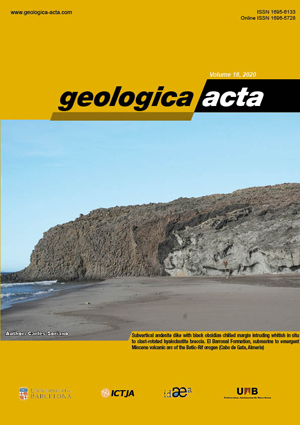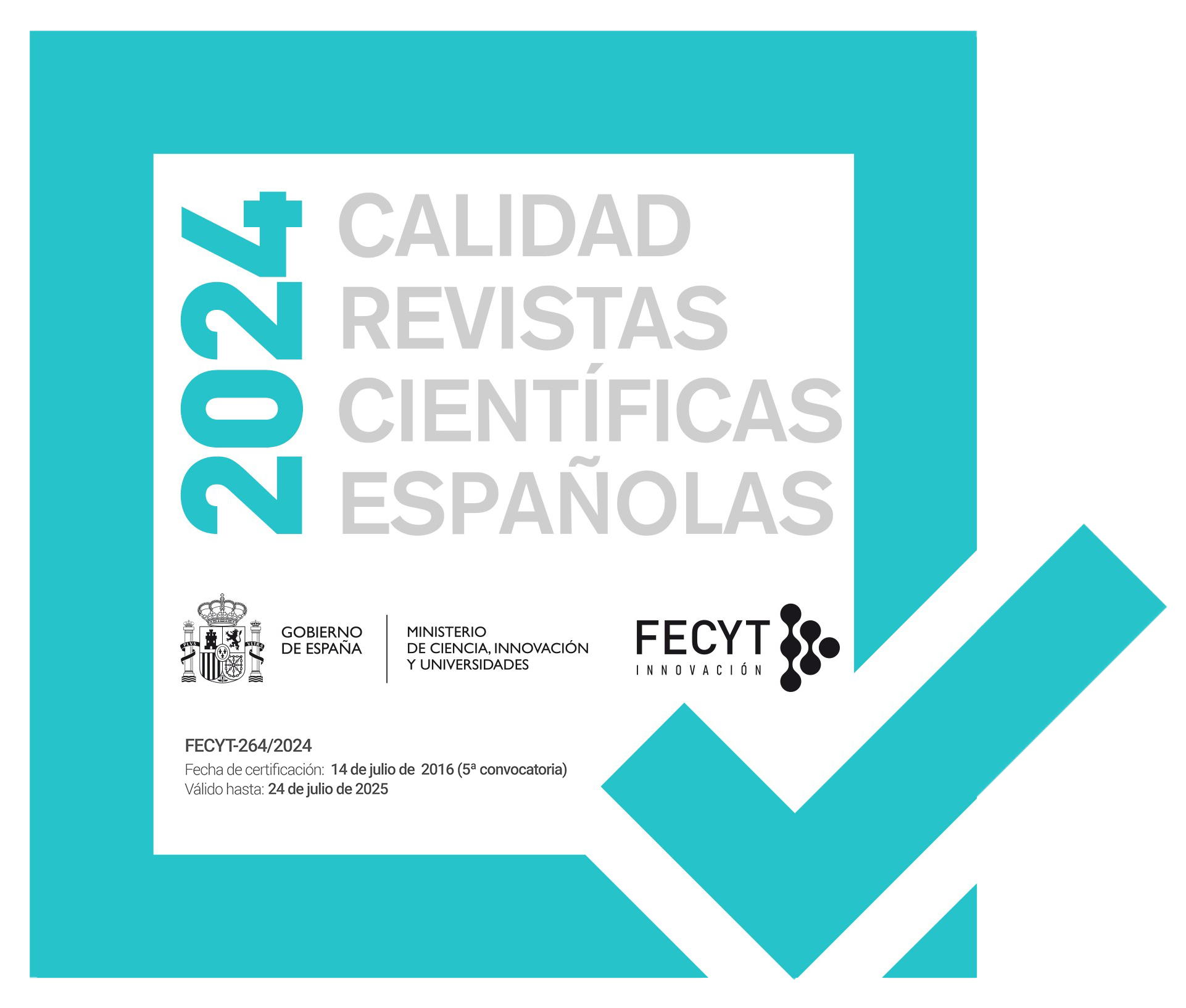Wildfire evidence from the Middle and Late Permian Hanxing Coalfield, North China Basin
DOI:
https://doi.org/10.1344/GeologicaActa2020.18.12Keywords:
Wildfire, Sedimentary rock, Permian, North China basinAbstract
Earth has a long geological history and palaeo-wildfire is one of the key factors which is responsible for the evolution and extinction of our earth systems. The most important extinction of our earth systems is the Permian-Triassic mass extinction. The objective of this paper is to evaluate the product of wildfire in terms of distribution and occurrences from the Late Permian North China basin. Fourteen rock samples were collected from a drill core of Hanxing Coalfield of North China basin. The samples were analyzed by macro and micro petrography, Scanning Electron Microscopy (SEM), Gas Chromatography (GC) and Gas Chromatography–Mass Spectrometry (GC-MS) in order to study the evidence of wildfire. Charcoal (inertinite) particles are observed in the samples, which established the occurrences of wildfire during the upper Middle and Late Permian time in North China. Additionally, high-molecular-weight Polycyclic Aromatic Hydrocarbons (PAHs) were detected in the studied samples which also reinforce the presence of palaeo–wildfire events in the North China basin in Late Permian due to the fact that these aromatic compounds were formed under high temperatures.
References
Ascough, P.L., Bird, M.I., Scott, A.C., Collinson, M.E., CohenOfri, I., Snape, C.E., Le Manquais, K., 2010. Charcoal reflectance measurements: implications for structural characterization and assessment of diagenetic alteration. Journal of Archaeological Science, 37, 1590-1599.
Arzadún, G., Cisternas, M.E., Cesaretti, N.N., Tomezzoli, R.N., 2017. Presence of charcoal as evidence of paleofires in the Claromecó Basin, Permian of Gondwana, Argentina: Diagenetic and paleoenvironment analysis based on coal petrography studies. GeoResJ, 14, 121-134.
Berner, R.A., 2006. GEOCARBSULF: a combined model for Phanerozoic atmospheric O2 and CO2. Geochimica et Cosmochimica Acta, 70, 5653-5664.
Degani-Schmidt, I., Guerra-Sommer, M., de Oliveira Mendonça, J., Mendonça Filho, J.G., Jasper, A., Cazzulo-Klepzig, M., Iannuzzi, R., 2015. Charcoalified logs as evidence of hypautochthonous/autochthonous wildfire events in a peat-forming environment from the Permian of southern Paraná Basin (Brazil). International Journal of Coal Geology, 146, 55-67.
Denis, E.H., Toney, J.L., Tarozo, R., Anderson, R.S., Roach, L.D., Huang, Y., 2012. Polycyclic aromatic hydrocarbons (PAHs) in lake sediments record historic fire events: validation using HPLC-fluorescence detection. Organic Geochemistry, 45, 7-17.
Finkelstein, D.B., Pratt, L.M., Curtin, T.M., Brassell, S.C., 2005. Wildfires and seasonal aridity recorded in Late Cretaceous strata from south – eastern Arizona, USA. Sedimentology, 52, 587-599.
Flannigan, M.D., Krawchuk, M.A., de Groot, W.J., Wotton, B.M., Gowman, L.M., 2009. Implications of changing climate for global wildland fire. International journal of wildland fire, 18, 483-507.
Freeman, D.J., Cattell, F.C.R., 1990. Woodburning as a source of atmospheric polycyclic aromatic hydrocarbons. Environmental Science & Technology, 24, 1581-1585.
Glasspool, I.J., Scott, A.C., 2013. Identifying past fire events. In: Belcher, C.M. (eds.). Fire phenomena and the Earth system:
An interdisciplinary guide to fire science. Oxford, John Wiley & Sons, 179-206.
Grasby, S.E., Sanei, H., Beauchamp, B., 2011. Catastrophic dispersion of coal fly ash into oceans during the latest Permian extinction. Nature Geoscience, 4, 104-107.
Guo, Y., Bustin, R.M., 1998. FTIR spectroscopy and reflectance of modern charcoals and fungal decayed woods: implications
for studies of inertinite in coals. International Journal of Coal Geology, 37, 29-53.
Hossain, H.Z., Sampei, Y., Roser, B.P., 2013. Polycyclic aromatic hydrocarbons (PAHs) in late Eocene to early Pleistocene mudstones of the Sylhet succession, NE Bengal Basin, Bangladesh: Implications for source and paleoclimate conditions during Himalayan uplift. Organic geochemistry, 56, 25-39.
Hu, S.R., Gao, W.T., Liu, H., 1990. The discovery of the plane of unconformity under bottom surface of Pingdingshan sandstone and the preliminary discussion about the boundary of the Permian–Triassic system, Henan Province (in Chinese). Coal Geology and Exploration, 4, 12-15.
ICCP, 2001. The new inertinite classification, International Committee for Coal and Organic Petrology (ICCP) System 1994. Fuel, 80, 459-471.
Jasper, A., Guerra-Sommer, M., Hamad, A.M.B.A., Bamford, M., Bernardes-de-Oliveira, M.E.C., Tewari, R., Uhl, D., 2013. The burning of Gondwana: Permian fires on the southern continent—a palaeobotanical approach. Gondwana Research, 24, 148-160.
Jiang, C., Alexander, R., Kagi, R.I., Murray, A.P., 1998. Polycyclic aromatic hydrocarbons in ancient sediments and their relationships to palaeoclimate. Organic Geochemistry, 29, 1721-1735.
Kauffmann, M., Jasper, A., Uhl, D., Meneghini, J., Osterkamp, I.C., Zvirtes, G., Pires, E.F., 2016. Evidence for palaeowildfire in the Late Permian palaeotropics—Charcoal from the Motuca Formation in the Parnaíba Basin, Brazil. Palaeogeography, palaeoclimatology, palaeoecology, 450, 122-128.
Kwiecińska, B.K., Petersen, H.I., 2004. Graphite, semi-graphite, natural coke and natural char classification ICCP system.
International Journal of Coal Geology, 57, 99-116.
Lenton, T.M., 2013. Fire feedbacks on atmospheric oxygen. In: Belcher, C.M. (eds.). Fire phenomena and the Earth system:
An interdisciplinary guide to fire science. Oxford, John Wiley & Sons, 289-308.
Li, H.Y., He, B., Xu, Y.G., Huang, X.L., 2010. U–Pb and Hf isotope analyses of detrital zircons from Late Paleozoic sediments: Insights into interactions of the North China Craton with surrounding plates. Journal of Asian Earth Sciences, 39, 335-346.
Manfroi, J., Uhl, D., Guerra-Sommer, M., Francischini, H., Martinelli, A.G., Soares, M.B., Jasper, A., 2015. Extending the database of permian palaeo-wildfire on Gondwana: charcoal remains from the Rio do Rasto Formation (Paraná Basin), middle permian, Rio Grande do Sul State, Brazil. Palaeogeography, palaeoclimatology, palaeoecology, 436, 77-84.
Meng, Y., Liu, X., Lu, S., Zhang, T., Jin, B., Wang, Q., Tang, Z., Liu, Y., Guo, X., Zhou, J., Xi, B., 2019. A review on occurrence and risk of polycyclic aromatic hydrocarbons (PAHs) in lakes of China. Science of The Total Environment, 651, 2497-2506.
National Commission of Stratigraphy of China (NCSC), 2014. The geologic time scale of China. Beijing, Geology Press, 1pp.
Petersen, H.I., Lindström, S., 2012. Synchronous wildfire activity rise and mire deforestation at the Triassic–Jurassic boundary. PLoS One 7, e47236. https://doi.org/10.1371/journal.pone.0047236
Robson, B.E., Collinson, M.E., Riegel, W., Wilde, V., Scott, A.C., Pancost, R.D., 2015. Early Paleogene wildfires in peat-forming
environments at Schöningen, Germany. Palaeogeography, Palaeoclimatology, Palaeoecology, 437, 53-62.
Scott, A.C., Jones, T.P., 1994. The nature and influence of fire in Carboniferous ecosystems. Palaeogeography, Palaeoclimatology, Palaeoecology, 106, 91-112.
Scott, A.C., Glasspool, I.J., 2005. Charcoal reflectance as a proxy for the emplacement temperature of pyroclastic flow deposits. Geology, 33, 589-592.
Scott, A.C., Glasspool, I.J., 2006. The diversification of Paleozoic fire systems and fluctuations in atmospheric oxygen concentration. Proceedings of the National Academy of Sciences, 103, 10861-10865.
Scott, A.C., 2010. Charcoal recognition, taphonomy and uses in palaeoenvironmental analysis. Palaeogeography, Palaeoclimatology, Palaeoecology, 291, 11-39.
Scott, A.C., Chaloner, W.G., Belcher, C.M., Roos, C.I., 2016. The interaction of fire and mankind: Introduction. Philosophical
Transactions of the Royal Society B, 371, 20150162. https://doi.org/10.1098/rstb.2015.0162
Shen, W., Sun, Y., Lin, Y., Liu, D., Chai, P., 2011. Evidence for wildfire in the Meishan section and implications for Permian–
Triassic events. Geochimica et Cosmochimica Acta, 75, 1992-2006.
Singh, M.P., Shukla, R.R., 2004. Petrographic characteristics and depositional conditions of Permian coals of Pench, Kanhan
and Tawa Valley Coalfields of Satpura Basin, Madhya Pradesh, India. International Journal of Coal Geology, 59, 209-243.
Stevens, L.G., Hilton, J., Bond, D.P.G, Glasspool, I.J., Jardine, P.E., 2011. Radiation and extinction patterns in Permian floras
from North China as indicators for environmental and climate change. Journal of the Geological Society, 168, 607-619.
Sullivan, R.F., Boduszynski, M.M., Fetzer, J.C., 1989. Molecular transformations in hydrotreating and hydrocracking. Energy & Fuels, 3, 603-612.
Sun, Y., Püttmann, W., Kalkreuth, W., Horsfield, B., 2002. Petrologic and geochemical characteristics of seam 9-3 and seam 2, Xingtai Coalfield, Northern China. International Journal of Coal Geology, 49, 251-262.
Sun, Y., Zhao, C., Püttmann, W., Kalkreuth, W., Qin, S., 2017. Evidence of widespread wildfires in a coal seam from the middle Permian of the North China Basin. Lithosphere, 9, 595-608.
Sýkorová, I., Pickel, W., Christanis, K., Wolf, M., Taylor, G.H., Flores, D., 2005. Classification of huminite–ICCP System 1994. International Journal of Coal Geology, 62, 85-106.
Van de Schootbrugge, B., Quan, T.M., Lindström, S., Püttmann, W., Heunisch, C., Pross, J., Fiebig, J., Petschick, R., Röhling,
H.G., Richoz, S., Rosenthal, Y., Falkowski, P.G., 2009. Floral changes across the Triassic/Jurassic boundary linked to flood basalt volcanism. Nature Geoscience, 2, 589-594.
Wang, J., 2010. Late Paleozoic macrofloral assemblages from Weibei Coalfield, with reference to vegetational change through the Late Paleozoic Ice-age in the North China Block. International Journal of Coal Geology, 83, 292-317.
Wang, J., Pfefferkorn, H.W., 2013. The Carboniferous–Permian transition on the North China microcontinent—oceanic climate in the tropics. International Journal of Coal Geology, 119, 106-113.
Wang, J., Xiao, L., Li, P., Arbuzov, S.I., Ding, S., 2019. Occurrence mode of selected elements of coal in the Ordos Basin. Energy Exploration & Exploitation, 37, 1680-1693.
Xu, Y., Uhl, D., Zhang, N., Zhao, C.L., Qin, S.J., Liang, H.D., Sun, Y.Z., 2020a. Evidence of widespread wildfires in coal seams from the Middle Jurassic of Northwest China and its impact on paleoclimate. Palaeogeography, Palaeoclimatology, Palaeoecology. DOI: https://doi.org/10.1016/j.paleo.2020.109819
Xu, Y., Zhang, N., Zhao, C.L., Liang, H.D., Sun, Y.Z., 2020b. Wildfires in Jurassic coal seams from Ordos Basin and its impact on paleoclimate. Geology in China. http://kns.cnki.net/kcms/detail/11.1167.p.20200130.1929.004.html
Yan, Z., Shao, L., Glasspool, I.J., Wang, J., Wang, X., Wang, H., 2019. Frequent and intense fires in the final coals of the Paleozoic indicate elevated atmospheric oxygen levels at the onset of the End-Permian Mass Extinction Event. International Journal of Coal Geology, 207, 75-83.
Yang, W., Hu, S.R., Ma, S.M., 2017. The relationship of paleontology, palaeobotany and coal thickness of Taiyuan Formation, Late Carboniferous-Early Permian in Shanxi Province. World Journal of Engineering, 14(2), 139-144.
Zhao, G., Cao, L., Wilde, S.A., Sun, M., Choe, W.J., Li, S., 2006. Implications based on the first SHRIMP U–Pb zircon dating on Precambrian granitoid rocks in North Korea. Earth and Planetary Science Letters, 251, 365-379.
Downloads
Published
Issue
Section
License
Copyright (c) 2020 Geologica Acta

This work is licensed under a Creative Commons Attribution-ShareAlike 4.0 International License.
Copyright
Geologica Acta is the property of the UB, GEO3BCN, IDAEA and UAB. Geologica Acta must be cited for any partial or full reproduction. Papers are distributed under the Attribution-Share Alike Creative Commons License. This license allows anyone to reproduce and disseminate the content of the journal and even make derivative works crediting authorship and provenance and distributing possible derivative works under the same or an equivalent license.
Author Rights
Authors retain the copyright on their papers and are authorized to post them on their own web pages or institutional repositories. The copyright was retained by the journal from the year 2003 until 2009. In all cases, the complete citation and a link to the Digital Object Identifier (DOI) of the article must be included.
The authors can use excerpts or reproduce illustrations of their papers in other works without prior permission from Geologica Acta provided the source of the paper including the complete citation is fully acknowledged.




